AP physics final
1/119
There's no tags or description
Looks like no tags are added yet.
Name | Mastery | Learn | Test | Matching | Spaced |
|---|
No study sessions yet.
120 Terms

If the large dot in Figure 2 represents the spacecraft, and the small dot in Figure 2 represents the object, which point on Figure 2 best approximates the location where the object will meet the spacecraft?
B
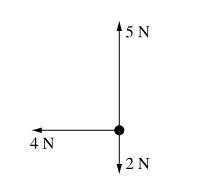
which of the following best represents the net force exerted on the object?

An object slides down an incline where there is friction between the object and incline, but negligible air resistance. Which of the following must be true about the resulting changes in the kinetic energy of the object and the gravitational potential energy of the object-Earth system?
The sum of the kinetic energy and the gravitational potential energy changes by an amount equal to the energy dissipated by friction.

At which of the labeled positions must an upward force of magnitude 2F be exerted on the meterstick to keep the meterstick in rotational equilibrium?
B
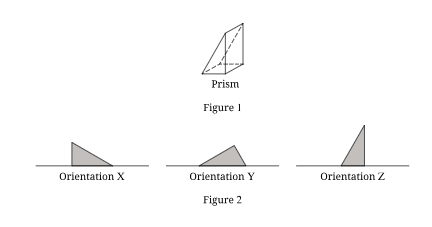
A solid prism in the shape of a right triangle as shown in Figure 1, can be placed in any of the three orientations shown in Figure 2. The prism is placed in a large tank containing a liquid and the prism sinks to the bottom of the tank. FX is the magnitude of the buoyant force exerted on the prism by the liquid in the tank when the prism is in Orientation X. FY and FZ are the buoyant forces for orientations Y and Z. Which of the following correctly ranks the magnitude of the three buoyant forces?
FY = FX = FZ
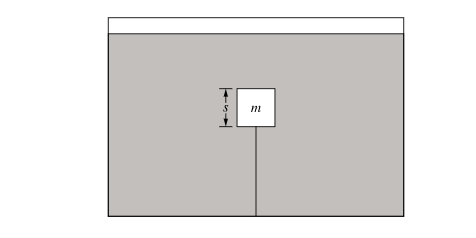
A cube of mass m with sides of length s is completely submerged in a tank of fluid of density ρf and held in place by a string attached to the bottom of the tank, as shown in the figure. The string has a nonzero tension FT. Which of the following indicates how the density of the cube ρc compares with the density of the fluid ρf and provides correct evidence for the comparison?
pc < pf because F tension is not zero
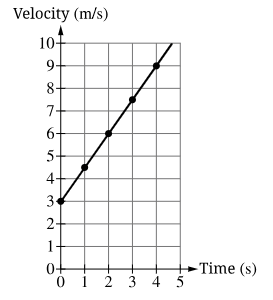
What is the avg acceleration
1.5 m/s²

Ball X is released from rest from a height H at time t=0. At the same time, an identical ball, Ball Y is thrown straight up from the ground, as shown in the figure. At time t=tf, Ball X is just above the ground and Ball Y is momentarily at rest at height H. Which of the following is a correct statement regarding the amount of mechanical energy in the system consisting of only one ball at time t = tf?
The mechanical energy of Ball X is greater than the mechanical energy of Ball Y at time t = tf
Two students of equal mass run to the top of a hill from opposite sides of the hill as shown in the figure. Each student reaches the top of the hill in the same amount of time, but Student Y needs to run twice the distance because their path is less steep. How does the rate of work done by Earth on by Student X, Px, compare to the rate of work done by Earth on by Student Ym,Py, as the students run up the hill
Px=Py
Block 1 is attached to a stretched spring which is also attached to a wall as shown in the figure. Block 1 is released from rest from position +x and it oscillates in simple harmonic motion between positions +x and -x with a maximum kinetic energy K1. Block 1 is replaced with Block 2 of mass 2m. Block 2 is also released from rest from position +x, and Block 2 oscillates in simple harmonic motion between positions +x and -x with a maximum kinetic energy K2. Which of the following correcty compares K1 and K2
K2=K1
A uniform disk, Disk A, of mass m and radius R rotates about an axis through the disk’s geometric center as shown in Figure 1. The rotational inertia for the disk in this configuration is I=12mR2. An identical disk, Disk B, rotates about an axis that passes through the edge of the disk, a radial distance R from the center of the disk as shown in Figure 2. The same torque is exerted on both disks, and disks A and B experience angular accelerations αA, and αB, respectively. Which of the following is a correct expression for the ratio of the two angular accelerations, αB/αA?
1/3
An empty container with volume 0.02 m3 is placed on a scale, which then reads 10N. An unknown liquid is then poured into the container until the container is completely full. The new reading on the scale is 170 N. Which of the following is most nearly the density ρ of the unknown liquid?
800 kg/m³

Which of the following best describes the motion of the object?
The object travels in the same direction for the entire time.
Planet X has a radius R and mass M. Planet Y has a radius 2R and mass 2M. Objects dropped from rest near the surface of Planet X and Planet Y experience accelerations due to gravity of aX and aY, respectively, during their first second of falling. Which of the following correctly represents the ratio aX/aY ?
2
A cart of mass m rolls down a track and through the circular bottom of the track (Point P) as shown in the figure. Which of the following statements about the normal force FN of the track exerted on the cart at Point P is correct and provides correct justification?
FN is greater than mg at Point P, because the cart is experiencing an upward acceleration.
A ball collides with the floor at an angle θ to the horizontal and bounces off the floor at the same angle and speed as shown in the figure. Which of the following vectors represents the impulse exerted on the ball by the floor?
straight up
Water is moving sequentially through two circular horizontal pipes, 1 and 2, respectively. The radius of Pipe 1 is r1 and the radius of Pipe 2 is 2r1. The speed of the water in pipes 1 and 2 is v1 and v2, respectively. Which of the following correctly represents v2/v1 ?
1/4
An object is thrown upwards from the surface of a small moon of radius R. The object rises to a height 3R above the surface of the moon before returning to the surface. Assuming frictional forces are negligible, which of the following forces are exerted on the object while it is on the way up?
Only a decreasing gravitational force that is exerted downward
Blocks 1 and 2 are connected by a string that passes over a pulley with negligible mass and friction, as shown in the figure. Block 1 is on a table covered with two different materials, A and B. The two-block system is released from rest, and the speed of Block 1 begins to increase. When Block 1 reaches Material B, its speed increases at a greater rate.
b
A rock with mass 2kg is dropped from the top of a building and falls straight down. The graph shows the vertical position of the rock as a function of time. From time t=0 to t=t1, the force of air resistance does −80J of work on the rock.
520 j
Graphs of the motion of two identical objects 1 and 2 are shown in Figure 1 and Figure 2, respectively. The change in velocity of Object 1 from t=0 to t=10s is Δv1. The change in velocity of Object 2 during the same time is Δv2.
deltav1>(deltav2=0)
A box of mass m is pulled in a straight line by a constant force F across a horizontal surface. There is friction between the box and the surface. The box initially moves with a velocity v0, and slows to a velocity v after a time t.
F-((mv-mv0)/t)
At time t=0s, a solid disk of radius 0.5m rolls without slipping across a floor with a constant translational velocity of v=4.5m/s. Which of the following is most nearly the rotational speed of the disk as it rolls?
Responses
9 rad/sec
A block of mass M is released from rest near the top of a ramp that is inclined at an angle θ with the horizontal as shown in the figure. The block slides down the ramp with negligible friction, traveling a distance d in a time t. The angle of the ramp is then decreased.
A (decrease decrease decrease)
A block slides down an inclined plane whose roughness varies, but whose incline is constant. The graph shows the block’s velocity as a function of time. The table lists the mechanical energy dissipated by friction over intervals 2 and 4.
abs delta E2 > abs elta E4
Block A of mass 2.0kg is released from rest at the top of a 3.6m inclined plane at an angle of 30°, as shown in the figure. After sliding down the incline and across the horizontal surface, Block A hits and sticks to Block B, which is initially at rest and has mass 3.0kg. Assume friction is negligible.
2.4 m/s
A box moving on a horizontal surface experiences a varying force that changes its velocity. The graph shows the velocity of the box as a function of time.
C
A disk of mass m and radius R is released from rest at the top of an incline and rolls down without slipping, as shown in the figure. While the disk is rolling it experiences an angular acceleration αdisk. Just before the disk reaches the bottom of the incline the velocity of the center of mass of the disk is vdisk. The experiment is repeated with a hoop of mass m and radius R. While the hoop is rolling it has an angular acceleration αhoop. Just before the hoop reaches the bottom of the incline, the velocity of the center of mass of the hoop is vhoop.
c
Three blocks of mass, m1, m2, and m3 are connected by strings as shown in the figure. When the system is released from rest, the blocks slide on the table. All frictional forces are negligible.
(m1m3g)/(m1+m2+m3)
Three spheres, with masses indicated in the figure, are initially far away from each other, and the gravitational potential energy of the three-sphere system is zero. The spheres are then brought together until each sphere is a distance r from the other two, as shown.
-(5Gm²)/r
A model rocket is launched vertically from the ground. The rocket is launched from rest and accelerates upward with acceleration a for a time t. The engine then shuts off and the rocket continues to move upward. Assume that the maximum height of the rocket is small compared to the radius of Earth.
((at²)/2)+((a²t²)/2g)
Two people are in a boat that is capable of a maximum speed of 5km/hr in still water. The people wish to cross a river 1km wide to a point directly across from their starting point.
1/3
A 1.0kg block is attached to an unstretched spring of spring constant 50N/m and released from rest from the position shown in Figure 1. The block oscillates and eventually stops moving 0.20m below its starting point, as shown in Figure 2.
-1 J
A uniform rectangular wooden door has a width w and mass m. When the door is opened, it rotates about an axis along its vertical edge, as shown in Figure 1, and has a rotational inertia of 13mw2.
(1/12)mw²
A horizontal spring of spring constant k=300N/m is compressed a distance x=0.1m by a 10kg block. The block is then released and allowed to slide along a horizontal table where the coefficient of kinetic friction between the block and table is μ=0.2.
1.0 m/s²
An ideal fluid with density 960kg/m3 fills the pipe shown in the side view and flows through it. The pipe has a circular cross section, and the speed of the fluid at Point A is 0.6m/s.
1.2×10³ Pa
At time t=t0, a slow-moving cart of mass mC is traveling to the right at speed v0. At time t=t1 a student drops a box of mass mB onto the cart. The box does not bounce but slides backwards relative to the cart. At time t=t2 the cart and box travel together at speed vf without slipping.
Which of the following is a correct expression for the change in kinetic energy of the cart-box system between times t=t1 and t=t2 ?
(1/2)(mc+mb)v²f - (1/2)mcv²0
At time t=t0, a slow-moving cart of mass mC is traveling to the right at speed v0. At time t=t1 a student drops a box of mass mB onto the cart. The box does not bounce but slides backwards relative to the cart. At time t=t2 the cart and box travel together at speed vf without slipping.
Which of the following statements correctly describes the change in momentum of the cart between times t=t1 and t=t2 ?
The momentum of the cart decreases because there is a net external force on the cart.
A block of mass m sits on a horizontal surface, where friction between the block and the surface is negligible. The block is attached to one end of an unstretched horizontal spring with spring constant k, and the other end of the spring is attached to a wall. The block is pulled to the right a distance D from equilibrium x=0 as shown in the figure. At time t=0 the block is released from rest.
((Dk)/m)cos(t(sqrt(k/m))
A horizontal platform is initially rotating about a vertical axis as shown in Figure 1. A stationary disk is dropped directly onto the center of the platform. A short time later, the disk and platform rotate together without slipping, as shown in Figure 2.
The angular momentum of the platform decreases. The top disk exerts a torque on the platform.
A ball is launched from the ground with an initial velocity of 8.0m/s at an angle of 60° above the horizontal. What is the approximate maximum height above the ground reached by the ball?
2.4 m
A horizontal disk rotates at a constant angular speed ω. As viewed from above, a coin of mass m on the disk moves counterclockwise in a circle of radius R, as shown.
to the right
A horizontal disk rotates at a constant angular speed ω. As viewed from above, a coin of mass m on the disk moves counterclockwise in a circle of radius R, as shown.
((Rw²)/g)
A nonuniform container is filled with water as shown in the figure.
D
A disk rolls without slipping down an incline as shown in Figure 1. A force diagram, which represents the forces exerted on the disk and the locations at which the forces are exerted, is shown in Figure 2. At the instant shown in Figure 1, Point P, which is on the edge of the disk is in contact with the incline.
The force of gravity only
A sphere is attached to the end of a string. The other end of the string is fixed. The sphere is pulled to the left and released from rest when the string is horizontal as shown. The sphere swings through Point Q, where the string is vertical.

At time t=0s, an object is moving with a velocity v that can be modeled by the equation v=(4.2m/s)−(1.4m/s2)t. When does the object change its direction of motion?
3
The graphs show the magnitude F of the force exerted on an object as a function of the object’s position x for two trials in an experiment. The force F is exerted in the direction of motion for both trials. W1 and W2 are the work done on the object by Force 1 and Force 2, respectively, as the object moves from x=0 to x=1.0m.
W1<W2, because the area under the curve of Force 1 over the region 0<x<1m is smaller than the area under the curve of Force 2 over the same region.
A projectile is launched with initial speed v0 at an angle θ0 above the horizontal. The projectile follows the trajectory shown in the figure.
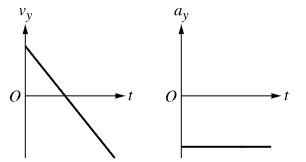
Four different constant forces are exerted on an object of mass 2.0kg. The figure represents the magnitude and direction of each force exerted on the object.
4
At the instant shown, three identical asteroids are in a line. Asteroid B is equidistant from asteroids A and C, as shown. The asteroids are in empty space such that the only forces on each asteroid are the forces from the other two. The positive x-direction is defined to be to the right.
FA,net>FB,net. The net force on Asteroid B is zero.
An object is traveling across a flat horizontal surface with a constant velocity v when a net force of magnitude F is exerted on the object. In which of the following cases does the kinetic energy of the object remain constant?
The force is exerted 90∘ from the direction of the velocity.
A block is pushed up an incline with a rough surface at a constant speed v with a constant force F which is parallel to the incline, as shown in the figure. The coefficient of kinetic friction between the block and the incline is μk.
1:2
A block is pushed up an incline with a rough surface at a constant speed v with a constant force F which is parallel to the incline, as shown in the figure. The coefficient of kinetic friction between the block and the incline is μk.
A
Students have a solid disk, a circular ring, and a square loop with masses and dimensions as shown. The dot at the center of the disk, ring, and loop represents the axis of rotation, which is perpendicular to the respective plane of each shape.
Il > IR > ID
Two systems are in oscillation: a simple pendulum consisting of a sphere on a long string that swings through a very small angle, and a block oscillating on a spring. The block-spring system takes twice as much time as the sphere-string system to complete one oscillation.
Decreasing the mass of both the block and the sphere
Water fills a pipe of radius r and has a speed v as it exits the pipe. The water flows into a large rectangular pool of length L, width W, and height H, as shown in the figure.
(LWH)/(pir²v)
In Scenario 1, a block is sliding across a smooth surface with a constant speed v0. When the block reaches a rough section, it slows to a stop in a distance D, as shown in the figure. In Scenario 2, an identical block is sliding with the same constant speed v0 across a smooth surface. When this second block reaches a different rough surface, it slows to a stop in a distance 4D. The time it takes for the blocks to stop in scenarios 1 and 2 is t1 and t2, respectively.
1:4
A student takes an object to the top of a very tall cliff and throws the object off the cliff either straight up or straight down. The graph represents the kinetic energy of the object as a function of time.
The object was thrown straight up. The kinetic energy decreases, then increases.
Spring A is attached at one end to a wall and at the other end to a block of mass M. The block is displaced a distance d0 from the equilibrium position of the block-Spring A system, as shown in Figure 1. With the block a distance d0 from equilibrium, the potential energy of the system is UA,1.
An identical spring, Spring B, is also attached to a wall and a block of mass M. The block is displaced a distance 2d0 from the equilibrium position of the block-Spring B system, as shown in Figure 2. With the block a distance 2d0 from equilibrium, the potential energy of the system is UB,1.
The blocks are returned to their equilibrium positions, and the potential energy of the block-Spring A system and the potential energy of the block-Spring B system are UA,2 and UB,2, respectively.
C
A stationary block explodes, breaking into three pieces of masses m, m, and 3m. The two pieces of mass m move off at right angles to each other with the same magnitudes of momentum mv, as shown in the figure.
to the upper right corner
A block of mass 2kg is sliding to the right across a horizontal surface with an initial speed of 3m/s, as shown in the figure. The block collides with a smaller block of mass 1kg that is initially at rest. After the collision, both blocks move to the right. The larger block has a final speed of 1m/s.
0
A horizontal beam of mass m and length L is attached at one end to a wall and at the other end by a cable extending to the wall. The angle formed by the cable and the horizontal is θ. A sign of mass M hangs from the end of the beam furthest from the wall, as shown in the figure.
((0.5m + M)g)/sintheta)
Two identical balls A and B are launched from ground level at the same time. Each is launched with initial speed of 50m/s but at different angles, as shown in the figure.
A
Blocks 1 and 2 slide toward each other on a horizontal track, as shown in Figure 1. There is negligible friction between the blocks and the track. Figure 2 shows a momentum bar chart that represents the magnitude and direction of the momentum of each block before they collide.
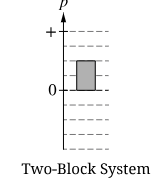
A box of mass m is initially at rest at the top of a ramp that is inclined at an angle θ with the horizontal. The block is at a height h and length L from the bottom of the ramp, as shown. The block is released from rest and slides down the ramp. The coefficient of kinetic friction between the box and the ramp is μk.
mgh - μk.mgLcostheta
A disk with rotational inertia I=2kg⋅m2 is free to rotate around an axle perpendicular to the plane of the disk and through its center with negligible friction. At time t=0, the disk has an angular velocity ω0=2rad/s clockwise, as shown in the figure. A counterclockwise torque τ=8N⋅m is exerted on the disk from time t=0 to t=2s.
12 kgm²/s
Two identical blocks, 1 and 2, are attached to strings suspended from the ceiling. The blocks are submerged in different fluids, as shown. Block 1 is submerged in Fluid 1 of density ρ0. Block 2 is submerged in Fluid 2 of density ρ02. Fluids 1 and 2 exert buoyant forces of magnitude F1 and F2 on blocks 1 and 2 respectively.
F1=2*F2
At time t=0 two identical blocks, A and B respectively, of mass m slide to the right across a horizontal surface. Block A slides across a part of the surface where friction between the surface and the block is negligible. Block B slides across a part of the surface where the coefficient of kinetic friction between the Block B and the surface is μk. At time t=0, both blocks have speed v0.
μkmg
A student allows a block to slide down a long ramp from various starting positions. The student records the time t for the block to travel a displacement Δx after being released from rest. The student creates a graph of Δx as a function of t2.
4
Block A of mass M initially rests on a table as shown in the figure. The force of friction between Block A and the table is negligible. Block A is connected to a string which hangs over a pulley. In Case 1 a force of magnitude F0 is exerted downward on the string. In Case 2 an object of weight F0 is attached to the end of the string. The acceleration of Block A and the tension in the string are indicated in the figure.
C
A sphere of mass m is thrown horizontally with a speed v0 from an initial height h0 above the ground. The sphere eventually lands on the ground.
sqrt(v²0 +gh0)
A student pushes a box of mass 2.0kg from rest in a straight line across a horizontal surface. Friction between the box and the surface is negligible. The student records the applied horizontal force as a function of the position of the box and creates the graph shown in the figure.
12 kgm/s
A wooden block with a mass of 2kg is moving with a speed of 12m/s across a horizontal surface at time t=0. The coefficient of kinetic friction between the block and the surface is μk=0.35.
3.4
A spring with a spring constant of 32N/m is attached to a wall. A block of mass 2.0kg is connected to the free end of the spring, as shown. The block is displaced 0.20m from the equilibrium position of the block-spring system which is located at x=0. The block is released from rest, and it oscillates on a horizontal surface where friction between the surface and the block is negligible.
0.17 m
Three identical wheels, A, B, and C, each have six regularly spaced spokes. A net force of magnitude F is exerted on each wheel, as shown in the figure.
Ta > Tb >Tc
A sphere is attached to a string of length 𝓁l which hangs from the ceiling. The sphere is pulled to the right until the string forms a small angle θ0 with the vertical as shown. The sphere is released from rest, and the sphere oscillates with period T. Several more trials are performed by releasing the sphere from rest from θ0 with different string lengths. The period of oscillations of the sphere is measured in each trial.
T² as a function of 𝓁
A sealed container has a rectangular panel that is 0.30m tall and 0.20m wide. The pressure outside the container is 35,000Pa and the pressure inside the container is 76,000Pa
2500 N
A disk is released from rest from the top of a ramp and rolls to the bottom without slipping. A sphere with the same mass and radius as the disk, but with a smaller rotational inertia, is also released from rest at the top of the ramp and rolls to the bottom without slipping. KD and KS are the total kinetic energy of the disk and sphere, respectively, at the bottom of the ramp.
KD=KS because the gravitational force does equal work on the sphere and the disk as they roll down the ramp.
A disk that is initially at rest is set into motion with a constant angular acceleration α. Which of the following expressions correctly represents the angular speed of the disk after it has made the first complete revolution?
sqrt(4pialpha)
The free-body diagram represents all the forces exerted on an object that is in motion, relative to the +x and +y directions shown in the figure. The relative magnitude of each force is indicated by the length of each vector.
+x
A 2.0kg object can move on a straight, horizontal track with negligible friction. The object is initially at rest at position x=0, when a horizontal force is exerted on the object. The force is measured as a function of the object’s position, and the data are shown in the graph.
4.0 m/s
Four objects, P, Q, R and S, can move along a straight horizontal track. The graphs in the figure show the position d of each of the objects plotted as a function of time t.
Object R
The free-body diagram shown represents the directions, but not the relative magnitudes, of all the unique forces exerted on a box.
3
A wheel with radius 0.33m and rotational inertia 2.0kg·m2 rotates on an axle that is perpendicular to the plane of the wheel and through the center of the wheel with an initial angular speed of 3rad/s. Friction between the axle and the wheel exerts a constant torque causing the wheel to stop after 6.0s.
1 Nm
A student throws a ball horizontally off the roof of a building that is 10m above the ground. The ball lands on the ground 3m from the bottom base of the building as shown in the figure.
3/sqrt(2)
A sphere of mass m and radius r rolls without slipping down a ramp that makes an angle θ with the horizontal, as shown. The magnitude of the acceleration of the center of mass of the sphere is a while the sphere rolls down the ramp.
alpha/radius
Two identical spheres, X and Y, each of mass m0 are connected by a rigid rod of negligible mass. The two-sphere–rod system slides with speed v0 across a horizontal track toward a curved ramp, as shown in Figure 1. When Sphere Y reaches a height h, Sphere X is still on the horizontal track, as shown in Figure 2. Frictional forces are negligible.
m0v²0 - m0gh
A block is attached to one end of a spring. The other end of the spring is fixed to a wall. The block is pushed against the spring so that the spring is compressed from its equilibrium length. The block is then released from rest and oscillates, undergoing simple harmonic motion. A graph of the position of the block as a function of time, where T represents a full period, is shown in the figure.
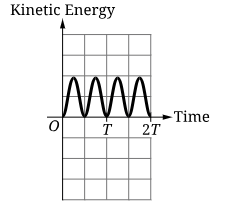
A cube of side length s rests on the bottom surface of a container of fluid as shown in the figure. The fluid is at a height y above the bottom of the surface of the tank. The fluid has density ρ and the atmospheric pressure is Patm.
Patm + pg(y-s)
The graph shows acceleration as a function of time data for an object that is at rest at time t=0s.
3 m
Three blocks; A, B, and C, are pushed by a constant force of magnitude F that is exerted on Block A as shown. There is negligible friction between the blocks and the horizontal surface. When a small disk is attached to the top of Block B, the magnitude of the normal force between blocks A and B is FAB and the magnitude of the normal force between blocks B and C is FBC.
D
A tall cylinder filled with water is open to the atmosphere at the upper surface. A small opening near the bottom of the cylinder allows the water to flow out of the cylinder in a narrow stream, as shown in the figure. Students perform an experiment to determine the relationship between the horizontal distance x the water travels before reaching the table and the vertical distance h between the hole and the surface of the water.
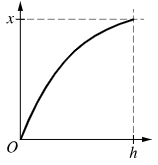
A theme park ride consists of a large vertical wheel of radius R that rotates counterclockwise on a horizontal axle through its center, as shown. The cars on the wheel move at a constant speed v. Points A and D represent the position of a car at the highest and lowest point of the ride, respectively.
0.5mv² + 2mgR
A theme park ride consists of a large vertical wheel of radius R that rotates counterclockwise on a horizontal axle through its center, as shown. The cars on the wheel move at a constant speed v. Points A and D represent the position of a car at the highest and lowest point of the ride, respectively.
D
Block 1, with mass m, moves towards Block 2, with mass 2m, on a straight horizontal track, as shown in Figure 1. Friction between the blocks and track is negligible. The relative magnitudes and directions of the block’s initial velocities are indicated with the velocity vectors shown in Figure 2. The two blocks collide
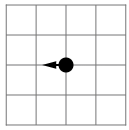
In Scenarios 1 and 2, Block Z hangs from a string that passes over a pulley and is attached to cart Y. In Scenario 1, Cart Y is attached to Cart X by a string. In Scenario 2, Cart Y is attached to Cart X by a spring, as shown in the figure. Frictional forces in both scenarios are negligible. When the carts-block systems in scenarios 1 and 2 are released from rest, the accelerations of the hanging block Z in the two scenarios as functions of time are a1(t) and a2(t), respectively.
a1(t)≠a2(t), because the tension in the string connected to Block Z is constant in one system but not in the other.
A spring is attached to a block at rest on a horizontal surface. The block-spring system is in equilibrium when the block is at position x=0 as shown in Figure 1. The block is then pushed to the left, so that the spring is compressed a distance x=0.5m as shown in Figure 2. The block is released from rest and allowed to oscillate in simple harmonic motion.
-0.43
An object with mass m is connected to a string that is attached to a ceiling. The object completes a circular path of radius r parallel to the ceiling, as shown, in time T1. The object is replaced with a new object of mass 2m which follows the same circular path of radius r in time T2.
T2 =T1
A block of mass m slides along a horizontal surface where friction between the block and the surface is negligible. The block initial has kinetic energy K0. The block collides with and sticks to a second block of mass 3m that is initially at rest.
0.25K0